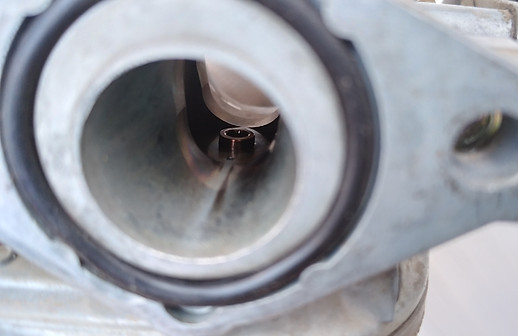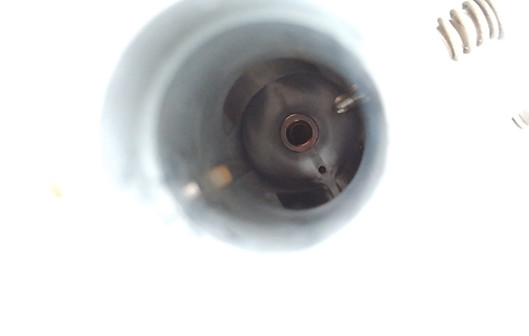
How to tune a Carburetor
This article provides a comprehensive guide on how to tune a carburetor, applicable to any Honda bike equipped with a throttle wire actuated slide, including models like the Honda CD70, Pridor, and Honda CG125.
Let's start from the basics
A carburetor operates based on the venturi principle. During the engine's intake stroke, air passes through a venturi in the carburetor, creating a low-pressure area. Within this venturi, a fuel jet is positioned. As air flows through the venturi, the low pressure causes fuel to be drawn through the fuel jet. The fuel then mixes with air and becomes atomized for combustion. The carburetor typically contains three air-fuel circuits from which the air-fuel mixture is supplied.
1: idle jet
2: needle jet
3: main jet
1:idle jet: The idle jet in a carburetor is responsible for regulating the fuel flow during idle and influences engine performance from idle to approximately 25% throttle position.
2: needle jetThe needle in the carburetor, typically attached to a slide or piston, controls the fuel supply from approximately 25% to 75% throttle position.
3: Main Jet: It supplies fuel from 75% to full throttle position.
It supplies fuel from 75% to full throttle position.

Front or engine side

Adjustment Screw Side

Air Filter Box Side
Tuning Idel Mixture
Every carburetor is equipped with an idle adjustment screw to regulate the idle mixture. This screw is typically located on the side or bottom of the carburetor. It can be either an air screw or a fuel screw. The fuel screw has a pointed tip, while the air screw has a rounded end. Both screws serve the same purpose: adjusting the idle air mixture. However, fine-tuning the mixture with the fuel screw is more precise but somewhat challenging, whereas adjusting it with an air screw is easier but may not achieve the same level of accuracy.
1:Adjusting fuel screw: With a fuel screw, the idle circuit maintains a constant supply of air, to which you add fuel to adjust the mixture. Turning the screw clockwise reduces the fuel supply to the air, while turning it counterclockwise increases the fuel supply, enriching the mixture at idle.
Turn the screw clockwise until the RPM starts to decrease, then turn it counterclockwise until the RPM drops again. This identifies the high and low points where the engine begins to struggle. Then, turn the screw a quarter turn clockwise at a time, waiting 5 seconds for the engine to adjust each time. Find the point where the engine RPM first decreases, then turn the screw slightly counterclockwise to locate the highest RPM point.
After adjusting the idle mixture, apply approximately 50% throttle and observe if the RPM drops smoothly without any backfire, engine struggles, or sudden increase in RPM. This ensures that the adjustment is optimal across different throttle positions.
If twisting the throttle results in a rise in RPM followed by a slow drop, indicating a lean air-fuel ratio, you can adjust it with the air screw. However, if adjusting the mixture screw doesn't resolve the issue, you may need to increase the pilot jet size.
If giving throttle causes the RPM to rise but the engine makes a sputtering sound while revving up to 25%, there may be too much fuel in the mixture. In this case, turn the screw to the right to find the point where the RPM is the highest and the throttle is smooth. If adjusting the mixture screw doesn't resolve the issue, you may need to reduce the pilot jet size by one size.


Idle Mixture Adjustment Screw in this case ( Air Screw)

Idle Adjustment Screw
Before Adjustment:
Warm up the engine: before adjustment ride the motorcycle for 20 minutes to fully warm up the engine.
Adjust the RPM: adjust the rpm to the recommended Idle RPM Suggested in the Owner's Manual. if your motorcycle engine rpm is too high you will skip the idle circuit completely .then it won't adjust properly.

Turn Left to decrease the Engine Rpm

Turn Right to Raise the Engine Rpm
Adjusting air screw: in case of the airscrew. you adjust the air supplied at the idle. and fuel is supplied to it also increases accordingly. after certain turns, the air supply increases to a point where the engine starts to struggle because of the lean mixture. because the fuel jet reaches its limit, the fuel stops increasing beyond that point.
if you will keep turning the screw to the left you will add more air.
How to find the highest rpm:
If after a certain point turning the screw doesn't affect RPM, turn it right again and notice when it starts to decrease RPM. From that point, turn it back until you achieve the highest RPM.
After achieving the highest RPM, give a little throttle and check for the response. If the RPM hangs and drops slowly, the mixture is lean. If the engine makes a sputtering sound while you give throttle, the idle mixture is rich. Adjust the screw accordingly to find the optimal mixture.

Idle Mixture Adjustment Screw in this case ( Air Screw)

Turn the air screw to the left to increase
the amount of air supplied to it

Turn the air screw to the right to decrease
the amount of air supplied to it
Adjusting c.v carburetor fuel screw: To access the idle mixture screw located at the bottom of a C.V carburetor, you may need to loosen the clamp and rotate it to a position where the screw is easily accessible. If the carburetor is solidly mounted, using a long screwdriver bit wrapped with tape for better grip can help reach the screw for adjustment.
Piolet jet: When adjusting the idle air-fuel mixture, if you find that the idle mixture screw is not providing the desired results, changing the pilot jet may be necessary. When changing the pilot jet, it's essential to move up or down one jet size at a time. For example, if you're upgrading from a 32-size jet, switch to a 33-size jet first, and then progressively adjust as needed by trying larger or smaller jets until the desired mixture is achieved.

Piolet Jet Alternate view

Piolet Jet

Piolet Jet Alternate view

Piolet Jet Circuite

Piolet Jet Circuite supplying fuel at idel
Needle Jet adjustment
In a carburetor, particularly those equipped with a slide-type design, the needle jet is a crucial component responsible for regulating the fuel delivery from 25% to 75% of the throttle position. This regulation occurs through the movement of the jet needle, which is controlled either by a throttle cable in the case of slide-pin or downdraft carburetors or by a diaphragm mechanism. This mechanism ensures precise control over the fuel delivery, optimizing the air-fuel mixture for efficient combustion and engine performance.
Access the needle jet
1: Slide pin carburetor: With this type of carburetor design, adjustments are relatively straightforward. Begin by removing the slide pin cap located at the top of the carburetor. Next, carefully detach the throttle cable, which is typically secured in place by a retainer spring. This process grants access to the internal components, allowing for adjustments to be made to optimize the carburetor's performance.
2: C.V carburetor:
In the case of a constant velocity (C.V.) carburetor, accessing the needle involves a slightly more intricate process. First, remove the top cover of the carburetor to reveal the diaphragm. Carefully extract the diaphragm and release the lock to free the needle. Before proceeding, ensure that all fuel has been drained from the float bowl to prevent any spills or contamination.
It's crucial to handle the diaphragm with care and avoid cleaning it with any type of carburetor cleaner or fuel. The diaphragm should remain dry as it is designed to function without any additional lubrication or cleaning agents. Using carburetor cleaner can cause the diaphragm to swell, preventing it from properly fitting into its designated grooves and potentially leading to cracks or brittleness over time.
Adjusting the needle height: The needle jet features a threaded section with grooves on the opposite side, typically ranging from 3 to 5. Adjusting the circlip to the top groove results in a lean air-fuel ratio, while moving it downward enriches the mixture.

Needle Jet with needle

Needle Jet view from the engine side

Needle Jet view from the top

Needle Jet Working

Needle Jet in Closed position

Air Rushing in the venturi as the throttle is opening and lifting the piston and needle jet

Fuel is Flowing from the jet as the needle jet is raise
Main jet Adjustment
The main jet affects the fuel ratio from 75% to full throttle.
Access the needle jet
To access the main jet, you'll need to open the carburetor bowl. Some carburetors feature a bottom bolt for easy access to the main jet. However, in most cases, you'll need to remove the bowl entirely to change the main jet.
There are few rules to adjust the main jet
Rule 1: If you're assembling a carburetor for an engine with unknown jetting requirements, begin by installing the largest main jet you deem appropriate based on air conditions. Then, progressively decrease the jet size. This method reduces the risk of hydrolock. Keep in mind that using too large a jet can flood the engine and lead to hydrolock, potentially bending the connecting rod. Conversely, using too small a jet can cause knocking. Thoroughly inspect the spark plug to detect any signs of engine damage.
Rule 2: When adjusting jetting, whether upjetting or downjetting, it's recommended to move two sizes at a time. For instance, if you were previously using a 72-size jet and intend to upjet, switch to a 74-size jet. Similarly, for downjetting, move down two steps, such as from 72 to 70 size. However, in some cases, jets may be available in a sequence like 72, 75, 78, and so on. In such instances, the specific number sequence doesn't matter. What's crucial is to follow the next available jet size in order, incrementing or decrementing until achieving the desired outcome.

Main Jet fig 1

Main Jet fig 2

Emulsion tube

Main Jet

main jet is installed on emulsion tube

Main jet and emulsion tube is installed on carburetor

Main jet and emulsion tube is installed on carburetor
Learn carburetor tuning in following articles.